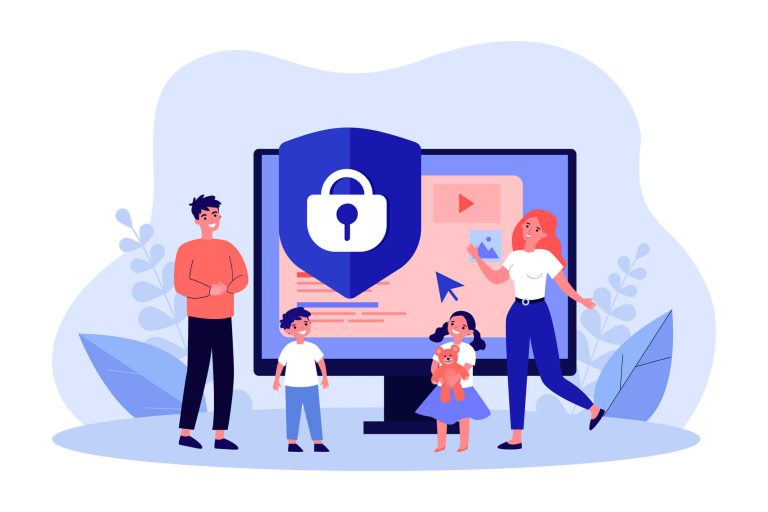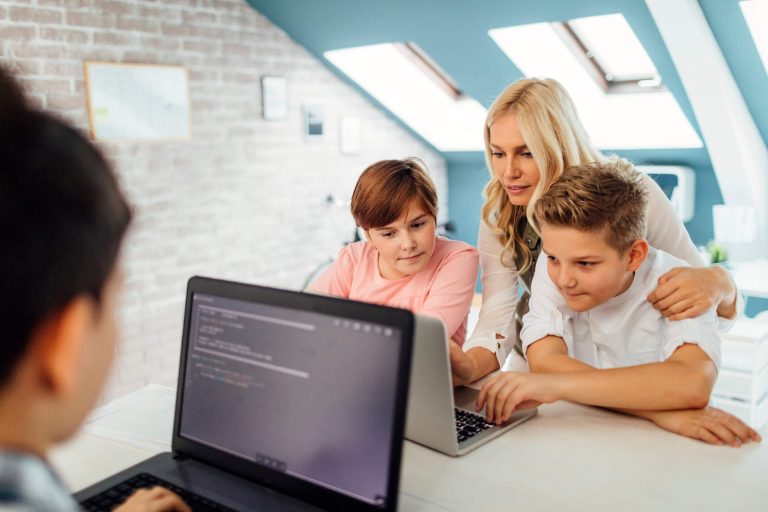In today’s digital age, where technology plays a significant role in our lives, coding has emerged as a powerful tool for communication with computers. Often referred to as computer programming, coding involves creating sets of instructions that guide computers to perform specific actions. By mastering this skill, individuals can communicate their ideas and creativity to machines, enabling them to accomplish tasks efficiently and rapidly.
Writing code resembles crafting a detailed set of instructions for a computer. Just as architects design blueprints for buildings and chefs create recipes for delicious meals, coding allows us to create a language that computers can understand. By learning to write code, especially from a young age, kids can harness the power to instruct computers on what to do or behave, empowering them to develop websites, build applications, process data, and engage in countless other exciting endeavors.
In the U.S., children aged 8 to 12 spend an average of 4 to 6 hours using screens daily, and teenagers dedicate up to 9 hours to digital devices, understanding and embracing coding becomes a crucial skill. Amidst the prevailing screen-centric lifestyle, teaching children to code can be a transformative experience. It enables them to utilize their screen time more meaningfully and imparts essential skills that contribute to academic success and prepare them for future opportunities in the workforce.
Table of Contents
Coding for kids goes beyond the technicalities
Coding for kids goes beyond its technical aspects. It nurtures critical thinking, problem-solving, and logical reasoning abilities, fostering intellectual growth in various domains. By engaging in coding activities, children strengthen their mathematical and writing skills, as coding requires logical reasoning, precise instructions, and the ability to break down complex problems into manageable parts.
Additionally, coding cultivates creativity, encourages perseverance, and instills resilience, qualities valuable not only in coding itself but also in navigating life’s challenges. Moreover, introducing coding to children early, in the long run, offers them an advantage.
Research suggests that early exposure to coding helps children develop computational thinking, encompassing analytical skills, algorithmic understanding, and the ability to approach problems systematically. These foundational skills create a solid framework for future learning, paving the way for academic achievements across various subjects and enhancing their prospects for success in a technology-driven world.
In this ultimate comprehensive guide, we aim to delve into the intricacies of coding, providing invaluable insights and resources tailored specifically for 12-year-olds. From fundamental concepts to hands-on projects, we will explore the exciting world of coding and equip young learners with the knowledge and skills they need to embark on a remarkable coding journey.

Getting Your 12-Year-Old Started with Coding
If your child has shown an interest in tinkering with computers, demonstrated excellence in math or science, or you simply want to equip them with valuable skills for their future success, introducing them to coding is an excellent next step. However, many parents may feel uncertain about how to get started. Fear not! We have some recommendations to set your child and yourself up for coding success.
1. Choose course formats that work best for your child
When selecting coding courses, consider your child’s learning style and preferences. Some children thrive as self-starters and may do well with self-paced online courses. These courses allow students to progress independently, providing flexibility and independence in their coding journey.
On the other hand, students who require more structure and accountability may benefit from live or online 1:1 or small group lessons. These formats provide guidance, support, and opportunities for personalized instruction, ensuring a more tailored learning experience. The best online group classes are available from CodaKid, IDTech, and Coding with Kids.
Coding is generally best taught in a 1:1 setting or self-paced format. In a classroom setting, the pace of the class often aligns with the slowest student’s progress, which can be frustrating for faster learners. But, if an in-person academy or camp makes sense for your child, we highly recommend courses from Code Ninjas or IDtech.
Opting for individualized or self-paced courses allows your child to learn at a pace that suits their capabilities and interests. If online private lessons are the best option for your child, we recommend the courses available from CodaKid and Juni Learning.
2. Choose engaging topics
Motivating your child is key to keeping their interest and enthusiasm alive. Different students find motivation through various project types, so exploring topics that resonate with your child’s interests is essential.
Game development, for example, is a popular choice as it combines coding concepts with creating interactive and entertaining experiences. Other exciting avenues are building websites, developing apps, or even programming robots. By discovering what excites your child, you can find courses that cater to their specific interests, making the learning process enjoyable and engaging.
3. Find the best classes for their age group
When considering programming languages for 12-year-olds, a few options are worth exploring. One recommended language for beginners is Scratch. While Scratch may initially appear “kid-oriented” for 12-year-olds, it is an excellent introduction to coding concepts. However, it is advisable to transition them to text-based coding when they are ready for a more robust programming experience.
Python is another highly recommended language for young learners. It is the fastest-growing programming language globally and is known for its simplicity and readability. Python is widely used in artificial intelligence, robotics, academia, data science, and large-scale web platforms. Its beginner-friendly syntax, and extensive libraries make it an ideal language for young coders, offering a solid foundation for their coding journey.
By selecting appropriate classes and programming languages tailored to their age and interests, you can provide your child with a stimulating coding experience that ignites their passion for technology and equips them with essential skills for the future.
4. Keep it going
Once your child shows an interest in coding, nurturing and sustaining that enthusiasm is crucial. Avoid treating coding as a one-time activity and instead aim for continued engagement. Seek recommendations from course instructors on suitable follow-on courses that can build upon their existing knowledge.
If your child initially learned in a classroom setting, consider opting for private courses to enable personalized learning and progress at their own pace. Additionally, introduce them to coding games and apps designed for kids, which can keep them engaged and learning outside of formal class sessions.
By maintaining their coding journey beyond a single course, you provide opportunities for ongoing growth and exploration in the exciting world of coding.

12-Year-Olds are the Perfect Age to Soak it Up
Age 12 is a pivotal time for children to absorb knowledge and acquire new skills. With their developing cognitive abilities, language proficiency, and computer literacy, 12-year-olds are poised to excel in coding.
Here are several reasons why they make exceptional learners and excellent candidates to embark on their coding journey:
- Advanced reading and comprehension skills – At the age of 12, children typically possess a solid command of reading and writing. Their ability to understand characters’ intentions and follow multiple storylines simultaneously allows them to grasp complex coding concepts more readily.
- Abstract thinking and problem-solving abilities – Cognitive development at this age enables 12-year-olds to engage in abstract thinking, making it easier to analyze problems and devise creative solutions. Their growing capacity for logical reasoning further enhances their problem-solving skills, aligning perfectly with the problem-solving nature of coding.
- Proficiency in language and communication – By age 12, most children have developed strong language and communication skills. They can comprehend figurative language, proverbs, and idioms, often used in coding and programming contexts. This linguistic competence allows them to navigate coding concepts beyond literal interpretations, enabling deeper understanding and application.
- Computer and keyboarding experience – Having had ample exposure to computers and digital devices, 12-year-olds are generally comfortable with technology and possess proficient keyboarding skills. This familiarity with computers and digital interfaces provides a solid foundation for learning and applying coding principles.
- Interest in game development and robotics – At this age, children often exhibit a keen interest in game development and robotics. These areas of coding can be highly engaging and motivating for 12-year-olds, encouraging them to explore and experiment with coding concepts in a fun and exciting way.
- Readiness for professional text-based coding languages – With their increasing cognitive abilities, 12-year-olds are well-positioned to tackle professional text-based coding languages. These languages, such as Python, offer a more comprehensive and versatile coding experience, allowing young learners to understand programming concepts better.
By capitalizing on their cognitive capabilities, language proficiency, and existing computer experience, 12-year-olds possess the ideal characteristics to dive into the world of coding. Whether their interest lies in game development, robotics, or other coding tracks, nurturing their coding skills at this age sets them up for a rewarding and successful journey in computer science.
Empowering Kids with Coding Skills
Coding offers 12-year-olds a gateway to a world of creativity, problem-solving, and future opportunities. By embracing coding at this critical age, children can leverage their advanced reading and comprehension skills, abstract thinking abilities, and proficiency in language and communication to excel in coding endeavors. With their familiarity with technology and readiness for professional text-based coding languages, 12-year-olds are primed to embark on an exciting coding journey.
To ensure their continued growth and development, it is essential to provide ongoing opportunities for learning and engagement. Seek recommendations for follow-on courses from instructors, explore coding games and apps designed for kids, and encourage your child to pursue their coding interests beyond the classroom. By nurturing their passion for coding, you can equip them with invaluable skills for the future and open doors to a world of possibilities.
Ready to embark on this coding adventure? Seek out coding classes for kids with CodaKid.com. We’re proud to be a trusted platform dedicated to teaching coding skills to young learners. Take the first step toward unlocking your child’s potential and empowering them with the tools they need for success in the digital age.
We hope you enjoyed Coding for 12 Year Olds – The Ultimate Guide. If you have any questions or comments please feel free to leave them below.

















